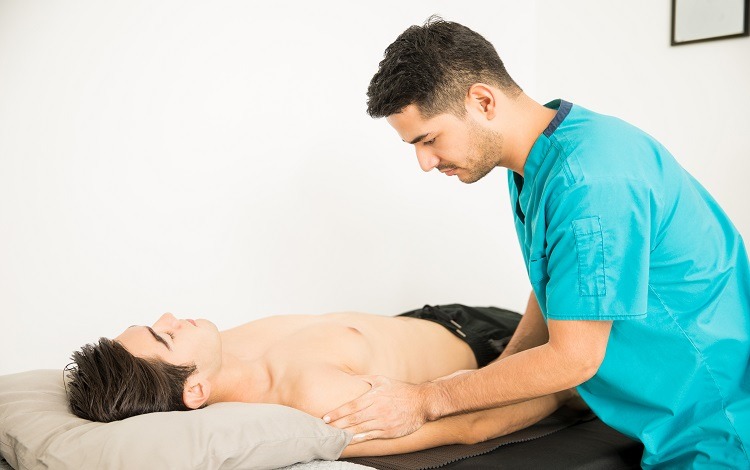If you are experiencing discomfort due to muscle tension or a pinched nerve, getting a deep-tissue massage is strongly recommended. Deep tissue massage is a therapeutic massage that concentrates on the deeper muscle layers and all of the connective tissues surrounding those specific muscle groups.
What Is A Deep Tissue Massage?
A deeply invigorating and rejuvenating body massage – deep tissue massage is a popular massage technique that realigns layers of muscles and deep tissues to dissolve muscle tension and chronic knots. A deep tissue massage uses deep finger pressure and gentle yet strong strokes to ease aches and pains in the neck, upper back, lower back, calf muscle, and shoulders.
A deep tissue massage will usually concentrate on your critical spots of soreness. However, it can also be applied on your arms if you suffer from tennis elbow or on your feet if you have plantar fasciitis. The increased pressure aids in the relief of any pain or imbalance induced by injury or muscle stiffness. If you suffer from worry or stress, a deep tissue massage will assist in relieving the tension in your body. A deep tissue massage in Dubai usually lasts between 60 and 90 minutes.
An Ayurvedic Approach to Deep Tissue Massage
Ayurvedic massage incorporates pressure points and the 5,000-year-old Indian principles of Ayurveda (the science of life). This style of massage is intended to bring equilibrium to the mind, body, and soul while also assisting the body in healing itself. It is frequently referred to as an “oil massage” since it typically combines warm herb essential oils, as well as long-standing and non-traditional strokes and kneading tailored to the client’s needs.
Does Deep Tissue Massage Work?
Deep tissue massage is a type of massage that wonders for stiffness, muscular injuries, lesions, aches, and pains. It can be extremely beneficial in alleviating unpleasant pain caused by various issues. It is a slow and pressurized movement massage that targets problem areas to make sure every muscle and its surrounding connective tissues are well-treated.
Adhesions develop as a result of muscle stress. These tissues become stiff, resulting in chronic and deeply unpleasant pain. Adhesions are known to induce inflammation, restriction of movement, pain, and even impede circulation. The danger of nerves being impacted or even trapped rises with inflammation, which can cause even more discomfort and result in you suffering greatly until you obtain the support you need to eradicate the pain and relieve the tension moving forward.
Deep tissue massage operates in the deep levels of muscle, dissolving adhesions and reducing pain. It is not an instantaneous success story; depending on the severity and degree of your muscle tension, you may require more than one visit.
Deep Tissue Massage – Ayurvedic Way
What makes Ayurvedic massage treatments different from the rest is their holistic approach and use of herbal oils and remedies. The five elements found in all living things—space, air, fire, water, and earth—are the fundamental components of life in Ayurveda. These combine to form three mind-body principles within the body known as doshas: Vata, Pitta, and Kapha. Everyone is born with a unique combination of the three doshas, with one being more dominant than the others. Ayurvedic medicine uses dosha balance and marma therapy to manage one’s physical and emotional well-being.
During an Ayurvedic massage, organic oil mixes are heated and infused with Ayurvedic herbs to encourage purification and relaxation. The oils are picked based on the predominant dosha of the individual. These oils enter the body through the skin pores at the right temperature, which are then released to cleanse the body.
An Ayurvedic therapist focuses on removing toxins from the body, balancing the chakras, and cleaning the energy channels in the body (energy centers). The style and flow of an Ayurvedic massage vary from one person to another. Experienced Ayurvedic massage therapists will use various massage techniques, such as tapping, kneading, and squeezing, as well as traditional massage strokes. The massage movements might be swift or slow, depending on the individual’s health condition. The whole strategy of Ayurvedic massage stimulates blood circulation and lymphatic drainage.
Deep Tissue Massage Benefits
The major perks of a deep tissue massage are closely related to both physical and mental wellness. Most massages are solely for relaxation. A deep tissue massage not only provides these benefits, but it also helps you psychologically with aches and rigidity. Below listed are some of the major benefits of deep tissue massage:
- Pain relief: Whether you’re dealing with a sports injury, a frozen shoulder, or a chronic illness like arthritis or migraine, deep tissue massage can help. Ayurvedic massage therapy has been proven effective in pain relief for various health conditions.
- Healing: Massage increases blood flow, which helps to reduce inflammation and promote faster recovery from injuries.
- Blood pressure: Ayurvedic deep tissue massage combined with lifestyle modifications and dietary changes helps lower blood pressure.
- Better flexibility: Deep tissue massage can increase the movement capacity in tight muscles, resulting in improved productivity, efficiency, and safer workouts.
- Relaxation: Massage always works wonders in soothing your body and soul, and deep tissue massage is no exception. Ayurvedic massage therapies stimulate the release of feel-good hormones, leaving you delightfully relaxed.
- Break-up scar tissue: Deep tissue massage therapy can help break up and eliminate scar tissue in the body. Often, scar tissue is closely linked with persistent discomfort and stiffness, and Ayurvedic massage therapy can alleviate these symptoms. Deep massage therapy is also highly suggested for those recovering from surgery.
What To Do After A Deep Tissue Massage?
You could expect to feel a little tender in the area that has been treated after a deep tissue massage. Most people experience drowsiness and thirst after the massage. This is quite common, and you can do a few things to resolve these issues.
- Drink water: Hydrating yourself is important. Drink plenty of water to improve blood flow and wash out toxins from your body. However, make sure to avoid caffeine and alcohol.
- Eat healthy food: You are more likely to feel hungry after an Ayurvedic massage. Instead of indulging in junk food or drinks, have healthy and nutritious snacks or meals.
- Have a proper rest: You need to rest and relax your body and mind to reap the benefits of an Ayurvedic massage. Allow your body to recover from the massage by waiting at least 24 hours before engaging in physical activity.
How To Give Yourself A Deep Tissue Massage?
There are several Ayurvedic massage practices, such as Marma chikista, uzhichil, udwarthanam, pizhichil, Abhyanga, and more. Among these, it is possible to do an abhyanga self-massage yourself by following the instructions and checking video tutorials. However, it is always recommended to seek the services of an experienced Ayurvedic practitioner to get yourself a deep tissue massage. An online search for ‘deep tissue massage near me’ would provide you with several options from which you can find a reliable Ayurvedic clinic in your region.
How To Do Deep Tissue Massage?
As mentioned earlier, a deep tissue massage involves applying sustained pressure on your inner layers of muscle and connective tissues using slow yet deep strokes. If you are planning to get an Ayurvedic deep tissue massage in Dubai, it is recommended to consult an expert practitioner for the best results.
Swasthya Ayurveda Medical and Wellness Clinic is an authentic Ayurvedic center that helps you to maintain a healthy mind and body. Under the astute leadership of Dr. Divya Menon, Swasthya Ayurveda follows a holistic view of physical and emotional health with Ayurvedic therapeutic massages and treatments.


